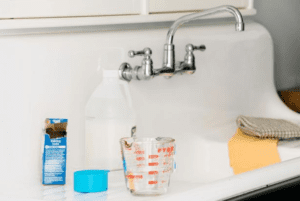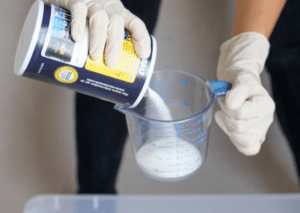Category: Home Remedies
Before reaching for the phone, explore DIY solutions with simple home remedies. Home remedies often provide a temporary fix. If the issue persists or seems complex, consult a professional plumber to avoid causing further damage.
Home Remedies For Clogged Sinks
Home Remedies For Clogged Sinks
There’s nothing nastier than standing in a backed up shower as the water level has risen up to your ankles. Yuck! Unfortunately, it happens to a lot of us. Next time you’re a victim of the drain (shower or sink), you can use household products you probably have on hand to solve the problem in a jiffy.
Some of these remedies are similar and use the same ingredients, just combined differently. However, they provide a safe and effective solution for your clogged drains.
Don’t use harsh store bought chemicals like Drano or Liquid Plumber. These products can do more damage than good. Plus, they are bad for septic tanks and the environment.
Before trying any of these, be sure to first remove your drain screen or stopper and wipe out any visible blockages with a paper towel.
Boiling Water + Salt
Clogs may be unavoidable, but you can reduce their frequency with some simple preventive steps. From disposing of grease in the garbage to using mesh drain covers – these at-home solutions help ensure clogs don’t develop so you won’t need DIY hacks like boiling water to clear your pipes!
While it may seem counterproductive, pouring salt down your sink may actually help clear a clogged drain. The coarse nature of table salt helps break up gunk and grime that accumulates inside your pipes clog them up, so be careful only using small quantities so as to not over-clog your drains.
Just as boiling water can help prevent future clogs, it can also help flush out an already stubborn one. Simply pour a pot of hot water down your drain and allow it to sit for several minutes, before carefully plunging it out again and repeating this process until your drain is clear.
If your clog persists despite these efforts, professional plumbers or commercial drain cleaners may need to be called in; chemical drain cleaners could potentially corrode pipes further down the road leading to costly repairs down the line if your blockage consisted of hair or grease accumulations.
Baking Soda + Vinegar + Salt + Boiling Water
Baking soda (sodium bicarbonate) is an environmentally-friendly kitchen product with many uses, from clearing out drains to eliminating mineral deposits and eliminating odors.
Furthermore, its slight disinfectant properties help eliminate germs and fungus growth – regular cleaning with baking soda can prevent future clogs.
Clogged kitchen sinks often result from an accumulation of food waste that cannot be properly processed by your garbage disposal system, including fat and grease build-up, stringy foods like celery stalks, starchy materials like pasta and potatoes, and eggshells – any or all of which may clog the drains in your kitchen.
For quick relief from blocked drains in the kitchen, mix together baking soda and salt before pouring it down the drain – this home remedy often works effectively!
After pouring one cup of baking soda down your drain, combine this with one cup of vinegar to produce a chemical reaction which may create foaming but which is actually working to loosen any gunk build-up inside your pipes.
Allow this reaction to run its course for five minutes or until foaming ceases; afterwards use hot water to flush away your drain and pipes.
If your drain clog is more stubborn, combine 1/2 cup baking soda and 1/4 cup salt in a sealed jar, shaking occasionally to evenly disperse these dry ingredients.
Pour this solution down your drain and allow it to sit for several hours (ideally overnight), before heating two cups of boiling water to flush through and flush out your system with this hot liquid.
Make yourself a note or reminder to do this first thing in the morning.
Baking Soda + Vinegar + Lemon + Cream of Tartar + Salt
If your sink drain is clogged with hair, combine baking soda and vinegar for an effective remedy. Doing this creates a chemical reaction that breaks down hair and other organic material before boiling water can flush away all debris from the drain.
Vinegar can be used for many other tasks, including cleaning and polishing wooden furniture, eliminating foul odors in many cases and eliminating stains from fabrics. Additionally, vinegar is frequently combined with other household products to clean drains and sinks effectively.
Adding lemon or cream of tartar to a baking soda and salt solution can increase its ability to combat clogs. This homemade solution for blocked drains that have caused strong odors is among the most effective available. Some prefer the smell of lemon over vinegar.
Pouring 1/2 cup of baking soda followed by one cup of vinegar into your drain can quickly and effectively loosen organic clogs such as hair.
As the mixture breaks down clogs, it should fizz away, which can then be replenished after 30 minutes with some boiling water from a pot.
Boiling Water + Carbinated Soft Drinks
A full pot of hot water can help flush a drain, but may not unclog more deep or stubborn clogs. One popular DIY solution to unclog deep or stubborn clogs involves pouring room temperature 2-liter soft drinks (preferably Coca~Cola) down the drain and waiting two hours before flushing, as these name brand drinks contain carbonated and acidic components which eat through grime and buildup in pipes to clear out debris from drains.
Salt + Borax + Vinegar
Borax is a naturally occurring mineral that is also known as sodium borate. It is commonly used in household cleaning products, such as laundry detergents and multipurpose cleaners.
Borax is also used in the production of glass, ceramics, and enamel. In addition, it has many industrial applications, including as a flame retardant and in the manufacture of fiberglass.
Despite its many uses, borax should be handled with care and kept out of reach of children and pets. It can be irritating to the eyes and skin if not properly used and stored.
Here is a concoction you can use:
- Pour 1/4 cup salt, followed 1/4 cup Borax down drain.
- Pour 1/2 cup vinegar down.
- Finish with a pot of boiling water.
- Let sit for one hour or until it clears.
- Run hot tap water to rinse any remaining solution down.

Last Resort - Toilet Plunger
Toilet plungers may be associated with clearing away clogs from toilets, but they can also be effective in unclogging sink drains. Simply insert the plunger over the clogged drain and pump several times up and down. This motion helps break up any hair or soap scum clinging together so it can pass down through.
In Conclusion
Kitchen sinks often become clogged due to food debris being washed down the drain and into its pipes, often becoming hardened and blocking up these arteries. You could potentially avoid this issue by installing a garbage disposal in your kitchen.
Bathroom sinks can quickly become clogged with hair, soap scum and other debris that clogs their curved drain lines, making it easy for hair strands, toothpaste or other materials to get caught inside them and cause blockages.
Grease is a notorious drain clogger in many homes. When combined with minerals in your water to form limescale, it can clog drains and pipes causing serious problems for drains and pipes alike. You can prevent this by pouring grease directly into a can or placing scraps directly in the trash instead of pouring it down your sink drain.
Trying some home remedies but the clog has persisted? If that hasn’t helped, calling in a professional plumber might be necessary. A trained expert can assess your clog’s size, type and location before using a suitable drain cleaning method to unclog it. Contact Discount Plumbers to discover more on how they can get your drains flowing again.
We’re located in Minneapolis, Minnesota but provide plumber near me services in 65 surrounding metro-areas. Our licensed, professional plumbers are in these cites daily.
Don’t hesitate to call the number below or fill our our webform here.








